Hardscaping plays a vital role in creating an impressive outdoor space. You can add definition, organization, and functionality to your backyard or outdoor area by incorporating various hardscape elements into your landscaping design. Hardscapes offer endless possibilities for transforming your outdoor space into a beautiful oasis, from patios and driveways to fences and water features. In this comprehensive guide, as your landscaping company will explore the world of hardscaping and discover how these built structures can enhance your landscapes.
What is Hardscape in Landscaping?
Before we delve into the various hardscape elements, let’s define what hardscape means in landscaping. Hardscape refers to all the non-living elements in your outdoor space, including brick, stone, concrete, wood, and metal structures. These decorative and practical elements provide structure, organization, and functionality to your landscapes. On the other hand, softscape refers to the living and organic elements in your garden or lawn, such as plants, trees, and grass.
Hardscape elements can be used to define different areas within your outdoor space or to create specific features. For example, a driveway can define the entrance to your property and provide a durable surface for parking your vehicles. A stone retaining wall can create planting areas or convert a sloped area into a flat yard space. Whether made of concrete, brick, or flagstone, patios offer versatile outdoor living areas for relaxation and entertaining. Fences and decks can provide privacy and security while adding aesthetic appeal to your landscapes. Additionally, water features like stone fountains or ceramic fountains can add a soothing ambiance and create focal points in your outdoor space.
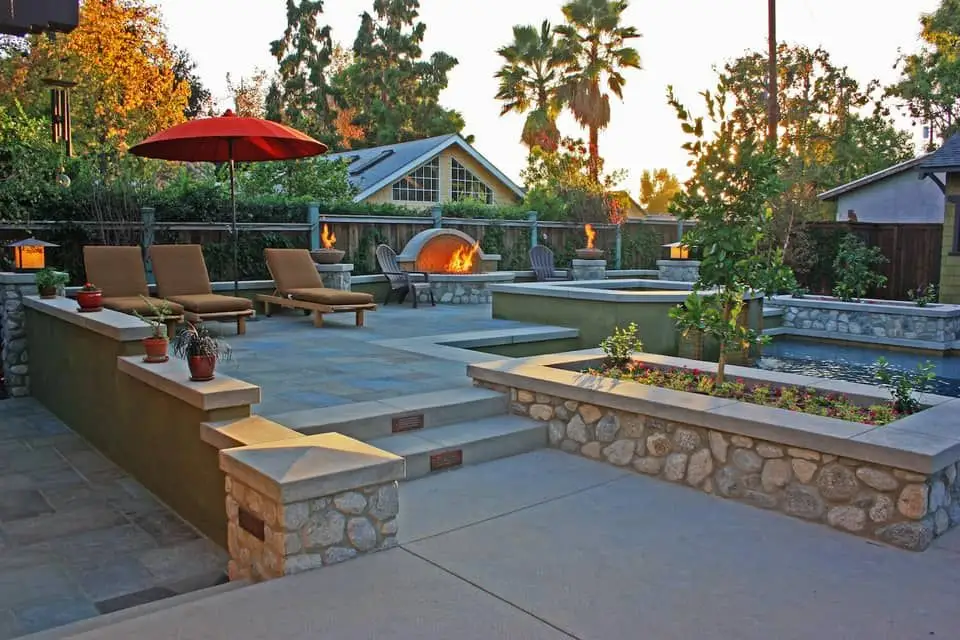
The Benefits of Hardscaping
Integrating hardscape elements into your landscapes offers numerous benefits. Here are some of the critical advantages of hardscaping:
1. Enhanced Functionality
Hardscapes provide practical solutions for various outdoor needs. A well-designed patio, for example, can serve as an outdoor dining area or a space for relaxation and entertainment. A driveway provides a stable surface for parking vehicles and improves accessibility to your property. Walkways and paths guide visitors through your outdoor space and create a sense of flow and organization. By incorporating hardscape elements, you can maximize the functionality of your outdoor area and make it more enjoyable for everyday use.
2. Increased Property Value
Investing in hardscaping can significantly increase the value of your property. Well-designed and well-maintained hardscape features add curb appeal and make your outdoor space more attractive to potential buyers. A beautifully constructed patio, for instance, can be a significant selling point for homeowners looking for a comfortable outdoor living area. Hardscaping not only enhances the visual appeal of your property but also adds functionality and versatility, making it a worthwhile investment.
3. Low Maintenance
Unlike softscape elements that require regular watering, pruning, and maintenance, hardscapes are generally low maintenance. Once installed, hardscape features like patios, driveways, and fences require minimal upkeep. Regular cleaning and occasional repairs are usually needed to keep them in good condition. This makes hardscaping a practical choice for homeowners who want to enjoy beautiful outdoor spaces without the hassle of extensive maintenance.
4. Improved Drainage and Erosion Control
Hardscape elements can help manage water drainage and prevent erosion in your outdoor space. Retaining walls, for example, can hold back soil and prevent erosion on steep slopes. Properly designed driveways and walkways can direct water away from your property and avoid flooding or water damage. By incorporating hardscaping techniques into your landscaping, you can effectively manage water flow and protect your outdoor space from erosion.
Popular Hardscape Elements
Now that we understand the benefits of hardscaping, let’s explore some of the most popular hardscape elements you can incorporate into your outdoor space.
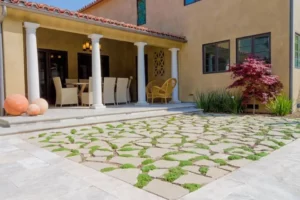 1.Patios
1.Patios
Patios are one of the most common hardscape features found in residential landscapes. They provide a versatile outdoor living area for relaxation, dining, and entertaining. Whether made of concrete, brick, flagstone, or tile, patios offer a durable and aesthetically pleasing surface for outdoor activities. From simple designs to elaborate patterns, patios can be customized to suit your style and preferences. Adding furniture, lighting, and decorative elements can create a cozy and inviting outdoor space that complements your landscaping.
2. Driveways 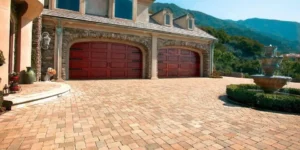
Driveways are essential hardscape elements that provide access to your property and parking space for your vehicles. They come in various materials, including concrete, asphalt, pavers, and gravel. When designing a driveway, it’s essential to consider factors such as the size of your vehicles, the slope of your property, and the overall aesthetics of your landscapes. A well-designed driveway not only improves functionality but also enhances the curb appeal of your property.
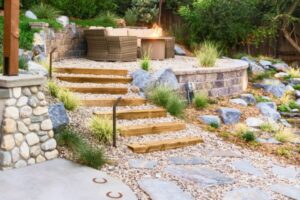 3. Retaining Walls
3. Retaining Walls
Retaining walls are hardscape structures that hold back soil and prevent erosion on sloped landscapes. They create terraced areas that can be used for planting or convert steep slopes into usable flat spaces. Retaining walls can be constructed using different materials, such as stone, brick, concrete blocks, or timber. They serve a practical purpose and add visual interest to your landscapes. Incorporating retaining walls into your hardscape design allows you to create multi-level gardens and maximize your outdoor space.
4. Walkways and Paths 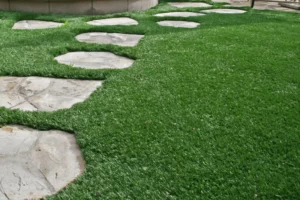
Walkways and paths are hardscape features that guide visitors through your outdoor space and connect different areas of your landscapes. They can be made of various materials, including concrete, stone pavers, flagstone, gravel, or wood. Walkways and paths provide a sense of direction and create a seamless flow between different zones in your outdoor area. By choosing materials that complement the overall design of your landscapes, you can add beauty and functionality to your outdoor space.
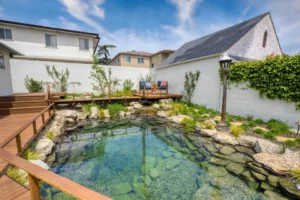
5. Fences and Decks
Fences and decks are hardscape elements that can enhance your outdoor area’s aesthetics and functionality. Fences provide privacy, security, and a sense of enclosure to your property. They come in various styles and materials, such as wood, metal, vinyl, or composite. Decks, however, provide elevated outdoor living, dining, and entertaining platforms. They can be attached to your house or built as freestanding structures. By incorporating fences and decks into your hardscape design, you can create defined spaces within your outdoor area and add visual interest to your landscapes.
6. Water Features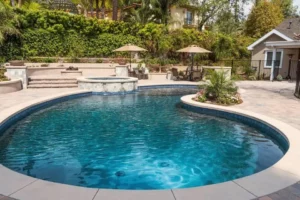
Water features, such as fountains, ponds, and waterfalls, can add a sense of tranquility and beauty to your outdoor space. They serve as focal points and create a soothing ambiance. Water features can be constructed using various materials, including stone, ceramic, or even repurposed items. The sound of flowing water can mask unwanted noise and create a serene atmosphere in your backyard. You can transform your outdoor space into a peaceful retreat by integrating water features into your hardscape design.
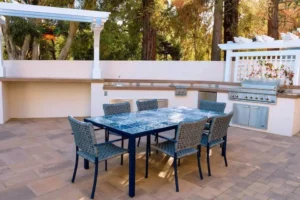 7. Outdoor Kitchens and Living Spaces
7. Outdoor Kitchens and Living Spaces
Outdoor kitchens and living spaces are becoming increasingly popular among homeowners who want to extend their living areas to the outdoors. These hardscape elements provide fully functional cooking and dining areas and comfortable seating and entertainment spaces. Outdoor kitchens can include grills, sinks, countertops, and storage. By incorporating these hardscape elements, you can create a seamless transition between your indoor and outdoor living spaces and enjoy the beauty of nature while cooking and entertaining.
8. Pergolas, Arbors, and Gazebos
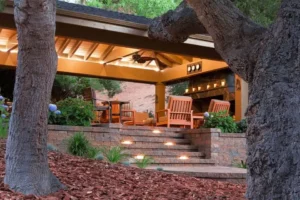
Pergolas, arbors, and gazebos are hardscape structures that add architectural interest and shade your outdoor space. They can be freestanding or attached to your house and often serve as focal points or gathering areas. Pergolas and arbors are typically covered with climbing plants, such as vines or roses, creating a natural, shaded canopy. Gazebos, on the other hand, are fully enclosed structures that provide shelter from the elements. Incorporating pergolas, arbors, or gazebos into your hardscape design allows you to add beauty, functionality, and a touch of elegance to your outdoor area.
Planning and Designing Your Hardscape
Designing and planning your hardscape is crucial in creating a beautiful and functional outdoor space. Here are some key considerations to keep in mind:
1. Assess Your Needs and Goals
Start by assessing your needs and goals for your outdoor space. Consider how you plan to use the area and what features are essential. Do you need a large patio for entertaining? Are you looking to create a peaceful garden retreat with water features? Understanding your needs and goals will help you prioritize and plan your hardscape design accordingly.
2. Consider Your Property’s Layout and Topography
Consider your property’s layout and topography when designing your hardscape. Consider factors such as slopes, drainage, and existing vegetation. Work with the natural features of your landscape to create a design that seamlessly integrates with the surroundings. Considering these factors, you can ensure that your hardscape design is practical and visually pleasing.
3. Choose the Right Materials
Selecting suitable materials is crucial for the success of your hardscape design. Consider durability, maintenance requirements, and aesthetic appeal when choosing materials for your patios, walkways, walls, and other hardscape elements. Consider the style of your home and the overall theme of your landscapes to ensure a cohesive and harmonious design.
4. Create a Focal Point
Incorporating a focal point into your hardscape design can add visual interest and create a sense of balance. This could be a water feature, a pergola, or a beautifully designed patio. A focal point draws the eye and serves as a centerpiece for your outdoor space. By creating a focal point, you can enhance the overall aesthetics of your hardscape design.
5. Seek Professional Help if Needed
If you need more clarification about designing and implementing your hardscape project, feel free to seek professional help. Landscape designers and contractors can provide valuable insights, expertise, and guidance throughout the planning and construction. They can help you create a design that meets your needs, ensures proper drainage, and maximizes the functionality and beauty of your outdoor space.
Maintaining Your Hardscape
Proper maintenance is essential to keeping your hardscape elements in good condition and prolonging their lifespan. Here are some maintenance tips to help you preserve the beauty and functionality of your hardscape:
1. Regular Cleaning
Regular cleaning removes dirt, debris, and stains from your hardscape elements. Sweep or hose down your patios, walkways, and driveways regularly to prevent the buildup of dirt and grime. For stubborn stains, consider using a pressure washer or specialized cleaning products. Additionally, remove any weeds or moss that may grow between pavers or on retaining walls to maintain their appearance.
2. Repairing and Sealing
Inspect your hardscape elements regularly for any signs of damage or wear. Repair any cracks or chips in your patios or walkways to prevent further deterioration. Sealing your hardscape surfaces can help protect them from stains, moisture, and UV damage. Consult with a professional or follow manufacturer recommendations for the appropriate sealing products and techniques for your specific hardscape materials.
3. Winter Protection
Protecting your hardscape elements during the winter months is crucial in colder climates. Remove any snow or ice promptly to prevent damage. Avoid using harsh chemicals or de-icers that can harm your hardscape surfaces. Instead, use sand or kitty litter to create traction on slippery surfaces. Consider covering delicate or vulnerable hardscape elements with tarps or protective covers to shield them from harsh winter conditions.
4. Proper Drainage
Proper drainage is essential to prevent water damage and erosion. Ensure your hardscape elements are appropriately graded and sloped to direct water away from your property. Clear any clogged drains or gutters to ensure efficient water flow. Regularly inspect your retaining walls and other drainage structures to ensure they function effectively.
Hardscaping is integral to landscaping, offering endless opportunities to enhance your outdoor space. Hardscape elements can transform your landscapes into a beautiful oasis, whether you’re looking to create a cozy patio, a functional driveway, or a tranquil water feature. By carefully planning and designing your hardscape, choosing suitable materials, and properly maintaining your hardscape features, you can enjoy a stunning outdoor space that complements your home and brings joy and relaxation to your life. Embrace the world of hardscaping and let your creativity flourish as you shape your landscapes into a masterpiece of beauty and functionality.

